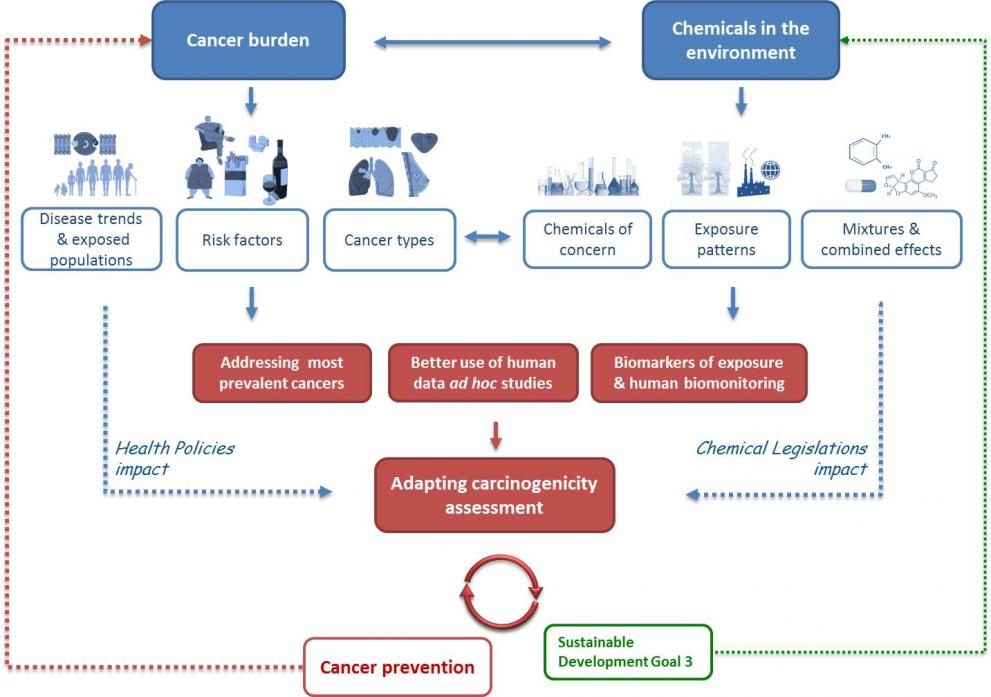
A new JRC study advocates a holistic approach to the safety assessment of chemicals that keeps pace with a changing environment and reduces their contribution to cancer risk.
We are surrounded by chemicals – in our food, cosmetics, household products, medicines, and the air we breathe. Some of them are potentially carcinogenic, so managing our exposure to these chemicals can significantly reduce the incidence of cancer in Europe and worldwide.
The JRC study focuses on how we can better assess carcinogenic properties of chemicals by taking better account of actual cancer burden and making better use of human relevant data and assessment tools.
The cancer burden in society
Incidence and prevalence rates for many cancers are increasing.
The figures speak for themselves: in 2018, more than 4 million new cancer cases were reported in Europe. Almost 2 million European citizens died because of cancer the same year.
Is cancer an inevitable burden in our society? "We have of course unavoidable risk factors, such as family history. For 5 to 10 per cent of cancer cases, significant correlations with specific inherited genes have been identified. Simply getting older also increases cancer risk", explains JRC scientist Federica Madia.
Importantly however, preventable risk factors collectively contribute to the development of most cancers. These include infections, exposure to sunlight, poor diet, being overweight, excessive consumption of tobacco and alcohol, and exposure to carcinogens at work or through everyday living.
"If we cannot completely avoid cancer, we can at least reduce its occurrence worldwide. Today, we can count on more sophisticated therapies than 20 years ago. However, we should also effectively manage relevant risk factors, including our exposure to chemicals", says Federica.
Chemicals and cancer
The European Union produces approximately 300 million tonnes of chemicals per year, of which 12-15% are classified as carcinogenic, mutagenic or toxic to reproduction (CMRs).
It is difficult to establish clear links between chemical exposure and the burden of cancer, and estimates are variable and uncertain. Studies put the contribution of chemicals to various types of cancer somewhere between 1 and 19%. Moreover, approximately 5% of childhood cancers have also been estimated to result from environmental exposure to pollutants.
A necessary legal framework
The European Union already has extensive regulatory measures in place to tackle the problem. In 2007 for example, the EU started to implement a comprehensive cross-cutting legislation on chemicals called REACH (Registration, Evaluation, Authorisation and Restriction of Chemicals) which contributes significantly to the identification and management of health risks linked to chemicals.
"We saw that all legislative measures put in place have successfully reduced cancer at work over the last 20 years. But today, we still have uncertainties regarding the potential risk posed by chemical exposure to the population through food, air, soil and water. It is difficult to assess the effects of mixtures, especially when there is a long latency of effects following exposure."
JRC scientists therefore call for new strategies and approaches for carcinogenicity assessment. They also call into question the standard testing procedures still relying on animal studies. "At the moment, chemicals are usually tested on mice and rats. But the results they give are not always relevant to humans and often lack sufficient reproducibility."

Carcinogenicity testing using animals has other issues too such as obvious ethical concerns, high costs and long study durations, all of which support a transition to more modern human-relevant approaches that exploit our understanding of the disease and our environment and which employ the latest non-animal methods available in a modern safety assessment toolbox.
Recommendations for adapting carcinogenicity assessment
According to the JRC researchers, public health policy actions cannot be decoupled from environmental policy actions.
The study recommends a holistic approach to better assess the carcinogenic properties of chemicals and manage their risk:
1. Prioritising the carcinogenicity assessment of chemicals for their potential to contribute specifically to the development of the four most prevalent cancers (breast, colorectal, lung and prostate cancers)
2. Make better use of information on cancer aetiology and evolution in humans
For example, increased cancer risk has been associated with several chronic disorders such as cardiovascular disease, diabetes, chronic kidney disease and pulmonary disease.
Moreover, interactions between chemical exposure and genetic and lifestyle factors may also play a role in the manifestation of various cancer types.
3. Use of biomarkers of exposure and human biomonitoring
Biomarkers give evidence of association between exposure to specific chemicals and a carcinogenic effect, and can therefore be used to enhance epidemiological studies.
Read more in:
F. Madia, A. Worth, M. Whelan, R. Corvi. (2019). Carcinogenicity assessment: Addressing the challenges of cancer and chemicals in the environment. Environment International. 128. 417-429.
DOI: 10.1016/j.envint.2019.04.067
Related Content
Carcinogenicity assessment: Addressing the challenges of cancer and chemicals in the environment
Details
- Publication date
- 13 June 2019
